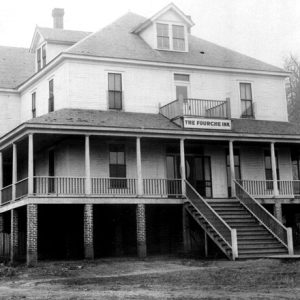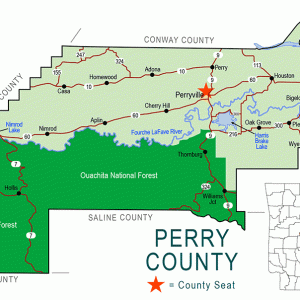calsfoundation@cals.org
Fourche (Perry County)
| Latitude and Longitude: | 34°59’38″N 092°37’16″W |
| Elevation: | 292 feet |
| Area: | 0.20 square miles (2020 Census) |
| Population: | 56 (2020 Census) |
| Incorporation Date: | December 2, 1906 |
Historical Population as per the U.S. Census:
|
1810 |
1820 |
1830 |
1840 |
1850 |
1860 |
1870 |
1880 |
1890 |
1900 |
| – | – | – | – | – | – | – | – | – | – |
|
1910 |
1920 |
1930 |
1940 |
1950 |
1960 |
1970 |
1980 |
1990 |
2000 |
| – |
164 |
94 |
88 |
51 |
48 |
46 |
51 |
55 |
59 |
|
2010 |
2020 |
||||||||
|
62 |
56 |
The town of Fourche (the name is pronounced to rhyme with “bush”) is located in northeastern Perry County on the banks of the Fourche La Fave River, for which it is named. Once a thriving lumber town, Fourche is now overshadowed by Bigelow (Perry County), its neighbor to the west.
The Fourche La Fave River was explored by a French settler, Peter La Fave, who gave his name to the river, “fourche” being the French word for “fork.” The first white settlers, who arrived after the Civil War, were German, including Gottlob Faisst, who owned a tomato cannery he named Central Arkansas Food Products Company. Faisst and his family also owned a wine saloon, skating rink, and pool hall, all located in the same building, which was used as a community center for the German settlers. Faisst’s most important company was the Bryant Lumber Company. The company, which employed many of the town’s citizens, was one of at least three such companies established in the area when the Choctaw, Oklahoma, and Gulf Railroad built a line into the area to transport harvested timber. The town of Fourche was incorporated in 1906.
When the timber industry flourished in the early years of the twentieth century, Fourche prospered, as did its neighbors Esau (later renamed Bigelow) and Graytown. Fourche had a train depot, a bank, and a cotton gin. A hotel, the Fourche Inn, was owned by Ben Kassle. It also had a stock yard; the Finkbeiner Meat Packing Company was founded in Fourche. A post office was established in Fourche in 1908, moved to Bigelow in 1912, reinstated in Fourche in 1916, and finally closed in 1933.
The competition between the towns reflected the competition between rival lumber firms. The Fourche River Lumber Company refused for a time to obtain a charter to operate in Perry County, which gave them greater negotiating power over local workers. In retaliation, agents for the Bryant Lumber Company obtained explosives and detonated a locomotive belonging to the Fourche River Lumber Company, also damaging a small section of railroad track. Following this act of violence, the Fourche River Lumber Company applied for and received a charter.
Lumber companies, in Fourche and elsewhere in Arkansas, also had some unsavory and sometimes criminal labor practices during this time. According to historian Nan Woodruff’s American Congo: The African American Freedom Struggle in the Delta, “Lumber companies often used convict labor or engaged in peonage. The Bryant Lumber Company of Fourche, Arkansas, recruited twelve unsuspecting Hungarian immigrants from New York City who spoke no English….When the immigrants arrived, the company seized their luggage and all of their clothes and forced them to live in a guarded boarding house run by an outside party. When people tried to run away, they were arrested.”
The population of Fourche in the early twentieth century included a number of African Americans. Both churches established in Fourche—one Baptist and one Methodist—were attended by black laborers and their families. A school was also established near Fourche.
By the end of the 1920s, the lumber industry of Perry County was declining, and many workers were moving away to find jobs elsewhere. The Flood of 1927 also threatened the riverside town. Both churches had closed by the mid-1950s.
Although a city hall was built in 1975, the town of Fourche has continued to decline in population. As of the 2010 census, the town had only sixty-two residents, all of whom were white. The only significant landmark in Fourche is the Faisst cemetery on the south end of town.
For additional information:
Living the Times, 1776–1976: A Bicentennial Tribute to Perry County. Casa, AR: Perry County Extension Homemakers Council, 1989.
Perry County Historical & Genealogical Society. Perry County, Arkansas: Its Land & People. Marceline, MO: Walsworth Publishing Company, 2004.
Steven Teske
Butler Center for Arkansas Studies
 Fourche Inn
Fourche Inn  Perry County Map
Perry County Map 




My great-uncle was the camp physician at this mill. His name was Dr. Edwin Kubale.
He died in 1923.